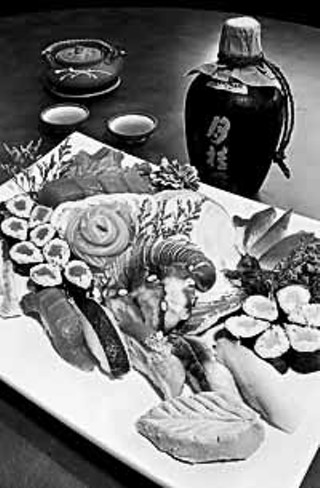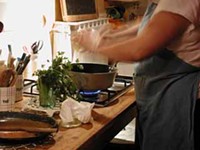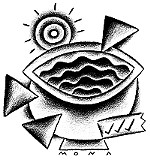Diverse Portfolio
Taking Stock at Gateway's Sushi Sake
By Pableaux Johnson, Fri., June 8, 2001

Sushi Sake
9503 Research Blvd., #500, 527-0888Mon-Thu, 11:30am-10pm; Fri-Sat, 11:30am-10:30pm; Sun, noon-10pm
Food historians often comment that "food follows the money," and in Austin's case it was a near-textbook case of nigiri/NASDAQ connection. The peak of Austin's tech boom also signaled a boom in Central Texas sushi joints. Chalk it up to an influx of Silicon Valley migrants or the return of expense-account mania, but the year 2000 saw an explosion in options for Austin's fishophiles. In the past year, high-dollar sushi establishments popped up everywhere from the Warehouse District (Kenichi) to the northeast (Kimchi) to the deep south side of town (Umi).
And in the fall, Sushi Sake opened up shop in the Gateway shopping plex, staking its claim on the highly populated (and hopefully highly profitable) Arboretum area. Perfectly situated for busy lunchtime traffic and evenings full of convenience-minded Nor'Westers, Sushi Sake started with a good location and designed a highly adaptable menu to widen their appeal.
Sake's menu covers the traditional sushi offerings served sashimi- (plain seafood cuts) or nigiri-style (fish on hand-shaped pad of sticky rice), as well as an assortment of specialty rolls containing everything from soft shelled crab and cucumber (the standard Spider roll) to smoked salmon, jalapeño, and cream cheese (the Tiger Eye). But in addition to the fishy favorites, the list also includes a wide array of other Japanese specialties from rice-and-meat donburi bowls to grilled teriyaki dishes and even the relatively rare vegetable/meat stews (tableside sukiyaki and shabu shabu). The list provides ample options for the sushi-averse diner -- plenty of beef or chicken dishes and tempura to boot -- including a section of vegetarian options. Sake fans have hot and cold options, including chilled, cloudy Nigori in hefty 12-ounce bottles. The lunchtime crowd can choose from about five sushi combinations and a healthy list of reasonably priced bento box specials.
And given its "nuevo strip mall" location, Sake's atmosphere is both well executed and well adapted to its audience. Burnished wood tones dominate the spacious dining room, with the occasional brushed metal or sculptural paper piece providing a sense of visual counterpoint. The main room is built around a sleek sushi bar with a good mix of banquette, booth, and table seating broken up into distinct sections that lend increased intimacy to the room's high-ceilinged spaciousness. To the rear of the space, two enclosed tatami/banquet rooms mimic the low-set tables of the Japanese tradition with a Western adaptation -- a sunken under-table well for a more chair-like experience.
Judging from the healthy traffic both at midday and at dinnertime, Sushi Sake's wide net has been successful. On recent visits, evening hours normally considered off-peak find many tables filled and elbow-to-elbow crowds at the sushi bar. Waits are common on weekends, especially to get closer to the sushi chefs.
In keeping with boomtime economics, the pricing at Sushi Sake is pronouncedly high-dollar, with one-piece orders of nigiri priced between $1.75 and $3.95. (The practice of charging a higher tag for two-piece portions seems to be less common in the newer sushi bars.) A high price tag, but consistent with the rest of the new upscale sushi bars. Heavy eaters beware.
All in all, the quality of the ingredients coming off the bar and of certain aspects of the preparation (notably the sticky rice) is both high and consistent. The hamachi (yellow tail, $2.25) was buttery and practically melted on the tongue. Likewise with the delicate hirami (flounder, $1.75) suggested by the server.
However, there was a consistent issue with both a combo and a la carte items that suffered from "structural problems" (for lack of an appropriate Japanese descriptor). Seafood layers of nigiri were flopping free from the foundation layer of rice. An otherwise tasty and interesting Scorpion roll (fried soft-shell crawfish with cucumber and spicy sauce, $6.95) was rolled so loosely that the cross-section slices crumbled at the first touch of a chopstick. These may be limited to peak rushes and an understandable down side of a high-traffic sushi bar, but the problems were noticeable and consistent on multiple visits. As a general sushi rule, it's always a good idea to jockey for a barside seat, but the seats at Sushi Sake's bar are coveted real estate, and the table orders shouldn't reflect a different standard.
The other Japanese specialties are consistently well executed -- especially the beef dishes, appropriate to a cattle-country sushi bar. In the gyutataki appetizer ($7.95), thin slices of rare beef -- a mimic of the legendarily decadent kobe beef -- are flash-seared around the edges and tender moist at the red center. Hearty lunchtime portions of teriyaki (grilled beef in sweet sake/soy marinade) are a filling bargain for under seven bucks.
Veteran fans of Japanese cuisine will welcome the inclusion of shabu shabu ($16.95) -- a brothy beef and vegetable dish prepared in a tableside hot pot -- under the menu's nabemono (quick stew) heading. One common preparation of shabu shabu is functionally analogous to Swiss fondue, with individual diners swishing paper-thin slices of raw beef in boiling broth just long enough to cook the beef, then dunking the meat into flavored sauces before eating. Vegetables (bok choy, onions, spinach, mushrooms) are gradually mixed in the seaweed-based broth for a savory soup course, along with the last-minute addition of silken tofu cubes and transparent yam noodles.
In some establishments, this process is largely controlled by the diner -- the high contraption and "pick your own morsel" factors adding to the experience. If you're a shabu shabu fan accustomed to the self-serve model, make sure to communicate this to your server. The house rules at Sushi Sake call for the server to add vegetables to the burbling pot in stages, ending with the tofu and the slices of meat on top. The problem with this method is that the meat cooks tough fairly quickly, and the resulting broth isn't particularly flavorful. On our shabu shabu visit, the resulting dish was watery broth with overcooked beef. Better to cook it yourself or choose another dish.
With the boom giving way to bust and the property-tax reaper making his grim rounds, it'll be interesting to see how many of the upscale sushi boomers will ride out the lean times. Deep-pocket dot-commies may be an endangered species, but the remaining 183/MoPac tech force will always be hungry around noon, sushi fanatics will always drag along carnivorous companions, and for better or worse, the Gateway/Arboretum area is Metro Austin's new center. With this solid trio of potential regulars, Sushi Sake seems to have followed "smart money" and should be well poised to ride out the slump. That is, if the rest of the city manages as well. ![]()








